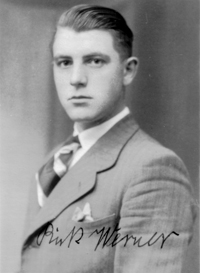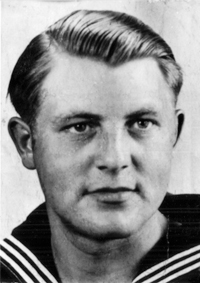|


Germany (1920)
Sources:
Werner Bösche (Son) / USA
Bundesarchiv Department PA
|
Werner Rick was born on July 17, 1920 in the small Rhineland town of Merken in the district of Düren. The town of his birth, which had 2,000 inhabitants at the time, lies between the cities of Aachen and Cologne and is now part of the district town of Düren. After his school and probably his apprenticeship, Werner Rick was drafted into the Reich Labor Service in November 1938 at the age of 18. He completed his six-month compulsory service at Reichsarbeitsdienstabteilung 8/213 in Leuscheid, 100 km away. Leuscheid is a wooded ridge in the extreme north of the Westerwald. In the town of the same name, there had been a labor service barracks camp called Schlageter since 1936. What work Werner Rick had to do here as a worker in the winter of 1938-39, in addition to the usual paramilitary drill, is not known. He had previously decided on a career in the Navy and then volunteered for service. Among other things, this prevented him from being called up for military service and he was able to choose the branch of the armed forces himself. Immediately after the end of the Reich Labor Service, he was drafted into the Navy. It was late March 1939 when his service began with basic training in the 5th company of the 7th ship cadre department in Stralsund. After three months of infantry training, a course at the anti-aircraft and coastal artillery school in Swinemünde followed. Werner Rick was trained here for two months on light machine guns as an anti-aircraft gunner.
 After completing the course, exactly one week before the start of the war, he was assigned to the battleship Schleswig-Holstein. It was his first command on board a ship and it promised to be exciting right away. On August 30, 1939 he sailed into Danzig with the Schleswig-Holstein under the pretext of a friendly visit. The true mission of the old ship was revealed the day after, when the ship, without warning, opened fire on the Polish fortress of Westerplatte. The Second World War had begun and Werner Rick was in the middle of it. After six days of tough fighting, Westerplatte was conquered, and the Polish defenders had put up dogged resistance to the end. The Schleswig-Holstein then continued shelling other sections of the coast. Werner Rick, who witnessed all this, left the ship in mid-September and attended another one-week course at the anti-aircraft and coastal artillery school in Swinemünde before joining the crew of the light cruiser Karlsruhe on September 29, 1939.
After completing the course, exactly one week before the start of the war, he was assigned to the battleship Schleswig-Holstein. It was his first command on board a ship and it promised to be exciting right away. On August 30, 1939 he sailed into Danzig with the Schleswig-Holstein under the pretext of a friendly visit. The true mission of the old ship was revealed the day after, when the ship, without warning, opened fire on the Polish fortress of Westerplatte. The Second World War had begun and Werner Rick was in the middle of it. After six days of tough fighting, Westerplatte was conquered, and the Polish defenders had put up dogged resistance to the end. The Schleswig-Holstein then continued shelling other sections of the coast. Werner Rick, who witnessed all this, left the ship in mid-September and attended another one-week course at the anti-aircraft and coastal artillery school in Swinemünde before joining the crew of the light cruiser Karlsruhe on September 29, 1939.
The Karlsruhe had been in the Wilhelmshaven naval shipyard for conversion work for over a year and was therefore taken out of service by its crew in mid-May 1938. Now that the end of the work was in sight, a new crew gathered to put the cruiser back into operation. On November 13, 1939, the time had come: the Karlsruhe returned to active service. Test drives followed before the ship was used for the "Weserübung" operation at the beginning of April 1940. At this point, Werner Rick was promoted to Ordinary Seaman 1st Class.
 In the early morning of April 8, 1940, the Karlsruhe left port. The fact that the new crew was not yet fully trained was accepted in order to be able to use as many ships as possible for the occupation of Norway. The cruiser's destination was the city of Kristiansand, which after several hours of firefights with a Norwegian coastal battery could finally be taken on the afternoon of April 9th. Heavy fog made the operation even more difficult and made the schedule obsolete. This also delayed the departure into the evening hours. Shortly after passing the Fjords, the Karlsruhe received a torpedo hit at 19:58 by the British submarine HMS Truant. Both machines and the steering gear failed. Water penetrated several departments and could not be stopped effectively. Werner Rick, who had been at his war watch station at the gun since leaving port, watched the events helplessly. While the Karlsruhe was already motionless and slowly sinking, submarine alarms were given several more times. The flak shot to supposed goals. Finally he received the order to abandon ship. The two torpedo boats Luchs and Seeadler took him and the rest of the crew and brought them to Kiel. 13 men were killed by the torpedo hit.
In the early morning of April 8, 1940, the Karlsruhe left port. The fact that the new crew was not yet fully trained was accepted in order to be able to use as many ships as possible for the occupation of Norway. The cruiser's destination was the city of Kristiansand, which after several hours of firefights with a Norwegian coastal battery could finally be taken on the afternoon of April 9th. Heavy fog made the operation even more difficult and made the schedule obsolete. This also delayed the departure into the evening hours. Shortly after passing the Fjords, the Karlsruhe received a torpedo hit at 19:58 by the British submarine HMS Truant. Both machines and the steering gear failed. Water penetrated several departments and could not be stopped effectively. Werner Rick, who had been at his war watch station at the gun since leaving port, watched the events helplessly. While the Karlsruhe was already motionless and slowly sinking, submarine alarms were given several more times. The flak shot to supposed goals. Finally he received the order to abandon ship. The two torpedo boats Luchs and Seeadler took him and the rest of the crew and brought them to Kiel. 13 men were killed by the torpedo hit.
 A two-month transitional period followed for Werner Rick at the 7th ship cadre department in Stralsund. Then his new command on board the main crew of the Bismarck was set. On June 22, 1940, he began his service as part of the light antiaircraft gun crew. During the next two months, the new battleship was still being fitted out before the crew could commission it on August 24, 1940. He went through testing and training again before his next mission began in May 1941. Twenty-year-old able seaman Werner Rick did not survive the sinking of the Bismarck.
A two-month transitional period followed for Werner Rick at the 7th ship cadre department in Stralsund. Then his new command on board the main crew of the Bismarck was set. On June 22, 1940, he began his service as part of the light antiaircraft gun crew. During the next two months, the new battleship was still being fitted out before the crew could commission it on August 24, 1940. He went through testing and training again before his next mission began in May 1941. Twenty-year-old able seaman Werner Rick did not survive the sinking of the Bismarck.
During the war he had married in his hometown of Düren. From the marriage a child named Inge had emerged. The widow was to remarry after the war. A second child named Werner was probably the result of an affair in Hamburg. The illegitimate son Werner Bösche only learned his father's name after the death of his mother in 1986. The family had been silent about the father and so it was a special pleasure for us to be able to bring the father closer to him through our research. Not only the military career could be determined via the Wehrmacht Information Office (today the Federal Archives Bundesarchiv Department PA), but also a first photo of Werner Rick, which was later to be followed by more. In 2007 Werner Bösche's father became a face for the first time in 66 years for him.
|
|